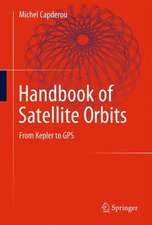Internetworking and Computing Over Satellite Networks
Editat de Yongguang Zhangen Limba Engleză Paperback – 31 oct 2012
Internetworking and Computing over Satellite Networks's emphasis is on data networking, internetworking and distributed computing issues. The material surveys recent work in the area of satellite networks, introduces certain state-of-the-art technologies, and presents recent research results in these areas. A variety of issues involving applications, network architecture, medium access controls, multicast routing, asymmetric routing, transport protocols, TCP performance enhancement techniques, data broadcast, and information disseminations, are addressed. This is one of the first books to be focused on the internetworking and computing aspect of satellite networks.
| Toate formatele și edițiile | Preț | Express |
|---|---|---|
| Paperback (1) | 640.06 lei 6-8 săpt. | |
| Springer Us – 31 oct 2012 | 640.06 lei 6-8 săpt. | |
| Hardback (1) | 647.27 lei 6-8 săpt. | |
| Springer Us – 30 apr 2003 | 647.27 lei 6-8 săpt. |
Preț: 640.06 lei
Preț vechi: 753.01 lei
-15% Nou
Puncte Express: 960
Preț estimativ în valută:
122.49€ • 127.15$ • 102.14£
122.49€ • 127.15$ • 102.14£
Carte tipărită la comandă
Livrare economică 22 martie-05 aprilie
Preluare comenzi: 021 569.72.76
Specificații
ISBN-13: 9781461350736
ISBN-10: 1461350735
Pagini: 288
Ilustrații: XXII, 262 p.
Dimensiuni: 155 x 235 x 15 mm
Greutate: 0.41 kg
Ediția:Softcover reprint of the original 1st ed. 2003
Editura: Springer Us
Colecția Springer
Locul publicării:New York, NY, United States
ISBN-10: 1461350735
Pagini: 288
Ilustrații: XXII, 262 p.
Dimensiuni: 155 x 235 x 15 mm
Greutate: 0.41 kg
Ediția:Softcover reprint of the original 1st ed. 2003
Editura: Springer Us
Colecția Springer
Locul publicării:New York, NY, United States
Public țintă
ResearchCuprins
1 The Role of Satellite Networks in the 21st Century.- 1 Introduction.- 2 Internet over Satellite Architecture.- 3 Common Applications.- 4 Visions for the Future.- 5 Challenges.- 2 Satellite Constellation Networks.- 1 Introduction.- 2 Benefits of Going to LEO.- 3 Describing the Systems.- 4 Geometry, Topology and Delay.- 5 Delay.- 6 Handover.- 7 Networking Design.- 8 Simulators.- 9 Summary.- 3 Medium Access Control Protocols for Satellite Communications.- 1 Introduction.- 2 Polling Based Access Protocols.- 3 Fixed Assignment Multiple Access (FAMA) Protocols.- 4 Random Access Protocols.- 5 Demand Assignment Multiple Access (DAMA) Protocols.- 6 Hybrid Protocols.- 7 Conclusions and Summary.- 4 Direct Broadcast Satellites and Asymmetric Routing.- 1 Introduction.- 2 Problems with Dynamic Asymmetric Routing.- 3 Tunneling: A Practical Solution.- 4 Demonstration of Tunneling Approach.- 5 RFC 3077: The IETF Standard.- 6 Limitations and Long-Term Solutions.- 5 Using Satellite Links in the Delivery of Terrestrial Multicast Traffic.- 1 Introduction.- 2 Overview of Multicast Deployment.- 3 Satellite Delivery of Multicast.- 4 Integrating Satellite and Terrestrial Networks.- 5 Using Satellite Paths for Multicast Sessions.- 6 When to Use Satellites?.- 6 TCP Performance over Satellite Channels.- 1 Introduction.- 2 Transmission Control Protocol (TCP) Overview.- 3 TCP Performance Problems over Satellite Links.- 4 Enhancing TCP Performance using Standard Mechanisms.- 5 Research Issues.- 6 Summary.- 7 TCP Performance Enhancement Proxy.- 1 Introduction.- 2 The Motivation.- 3 The Practical Solution.- 4 The Big Argument.- 5 The “Show Stopper”?.- 6 Conclusion.- 8 Performance Evaluation of TCP splitting over Satellite.- 1 Introduction.- 2 Model-based Analysis.- 3 Discussion.- 4 The ExperimentSystem.- 5 Measurement-based Analysis.- 6 Implications on System Design.- 7 Conclusion.- 9 Scheduling Data Broadcast.- 1 Introduction.- 2 The Basic Model.- 3 Theoretical Results.- 4 On-line Scheduling Algorithm.- 5 Performance Evaluation.- 6 Conclusions.- 10 Information Dissemination Applications.- 1 Introduction.- 2 IIDS architecture.- 3 Mobile User Profiling.- 4 Dynamic User Profile Clustering and Aggregation.- 5 Data Dissemination techiques.- 6 Implementation and Demonstration.- 7 Conclusions.









